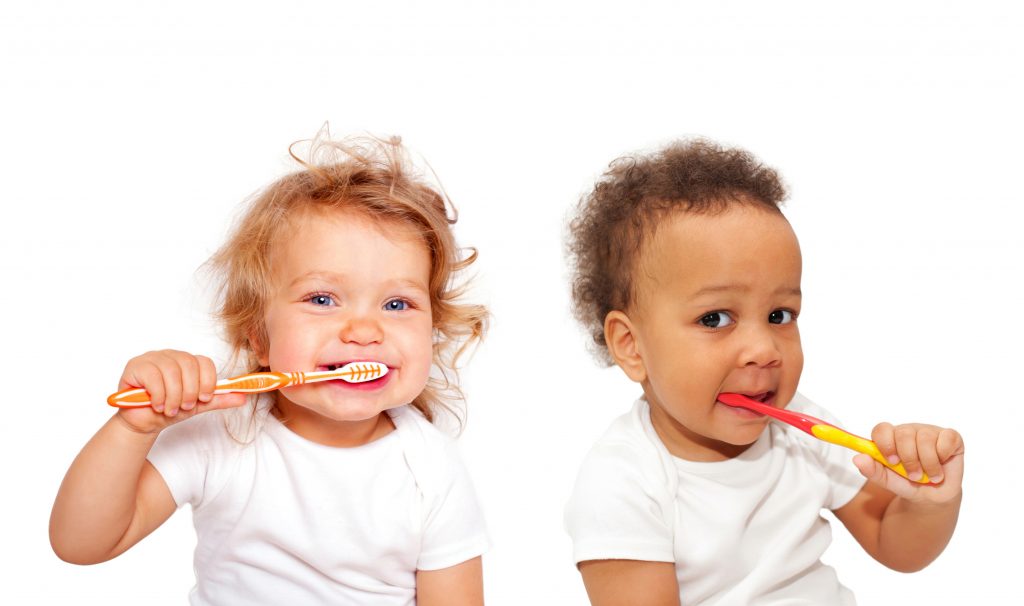Oral Health Training

Our Honeybear team members have completed Oral Health Training to ensure we are promoting good oral health behaviour within our Nurseries and encouraging families to do the same. As part of our commitment to promoting children’s good health we are applying for the ‘Tooth Safe Award’.
From brushing their first tooth to their first trip to the dentist, here’s how to take care of your children’s teeth.
A regular teeth-cleaning routine is essential for good dental health. Follow these tips and you can help keep your child’s teeth decay-free.
Toothbrushes – Toothbrushes should have a small head size (the toothbrush needs to be small enough to reach behind the back teeth and brush them easily). The bristles should be medium/soft so that they do not hurt the gums. Toothbrushes should be replaced at least every 3 months, or sooner if required. Toothbrushes should be individually identifiable for each child
Children aged up to 3 years
- Start brushing your baby’s teeth as soon as the first milk tooth breaks through (usually at around 6 months, but it can be earlier or later).
- Parents or carers should brush or supervise toothbrushing.
- Brush teeth twice daily for about 2 minutes with fluoride toothpaste.
- Brush last thing at night before bed and on one other occasion.
- Use children’s fluoride toothpaste containing no less than 1,000ppm of fluoride (check label) or family toothpaste containing between 1,350ppm and 1,500ppm fluoride.
- Use only a smear of toothpaste.
- Make sure children don’t eat or lick toothpaste from the tube.
Children aged 3 to 6 years
- Brush at least twice daily for about 2 minutes with fluoride toothpaste.
- Brush last thing at night before bed and at least on one other occasion.
- Brushing should be supervised by a parent or carer.
- Use children’s fluoride toothpaste containing no less than 1,000ppm of fluoride (check label) or family toothpaste containing between 1,350ppm and 1,500ppm fluoride.
- Use only a pea-sized amount of toothpaste.
- Spit out after brushing and don’t rinse – if you rinse, the fluoride won’t work as well.
Children aged 7 and over
- Brush at least twice daily for about 2 minutes with fluoride toothpaste.
- Brush last thing at night before bed and at least on one other occasion.
- Use fluoride toothpaste containing between 1,350ppm and 1,500ppm of fluoride (check label).
- Spit out after brushing and don’t rinse – if you rinse, the fluoride won’t work as well.
Children aged 7 and over should be able to brush their own teeth, but it’s still a good idea to watch them to make sure they brush properly and for about 2 minutes.
Taking your child to the dentist
- NHS dental care for children is free.
- Take your child to the dentist when their first milk teeth appear. This is so they become familiar with the environment and get to know the dentist. The dentist can advise you on how to prevent decay and identify any oral health problems at an early stage. Just opening up the child’s mouth for the dentist to take a look at is useful practise for the future.
- When you visit the dentist, be positive about it and make the trip fun. This will stop your child worrying about future visits.
- Take your child for regular dental check-ups as advised by the dentist.Ask your dentist about fluoride varnish or fissure sealing.
Between meal snacks
- Avoid sugary and acidic food / drinks between meals and an hour before bedtime
- Honey, smoothies, fruit juice and dried fruit are not tooth-friendly snack
- Milk is a tooth friendly drink during the day, water is tooth friendly at any time
- From 6 months onwards encourage the use of open top cups, discourage bottle use after the age of one year
- Remember to ask for sugar-free medicines whenever possible
How to brush
Place the head of the toothbrush against the teeth, then tilt the bristle tips to a 45 degree angle against the gum line. Move the brush in small circular movements, several times, on all the surfaces of every tooth
Brush the outer surfaces of each tooth, upper and lower, keeping the bristles angled against the gum line.
Do this again, but on the inside surfaces of all your teeth. To clean the inside surfaces of your front teeth, tilt the brush vertically and make several small, circular strokes with the front part of the brush.
Brush the biting surfaces of your teeth.
Spit out after brushing and do not rinse, so that the fluoride stays on the teeth longer.
Song to sing to your child
Brush, brush, brush your teeth
(Tune ‘Row, row, row your boat’)
Brush, brush, brush your teeth
Brush them every day
We put toothpaste on our brush
To help stop tooth decay
Clean, clean, clean your teeth
Clean them every day
Your teeth will sparkle for years to come
In the most beautiful way
Brush, brush, brush your teeth
Brush them every day
Happy, healthy teeth you’ll have
If it’s done this way


